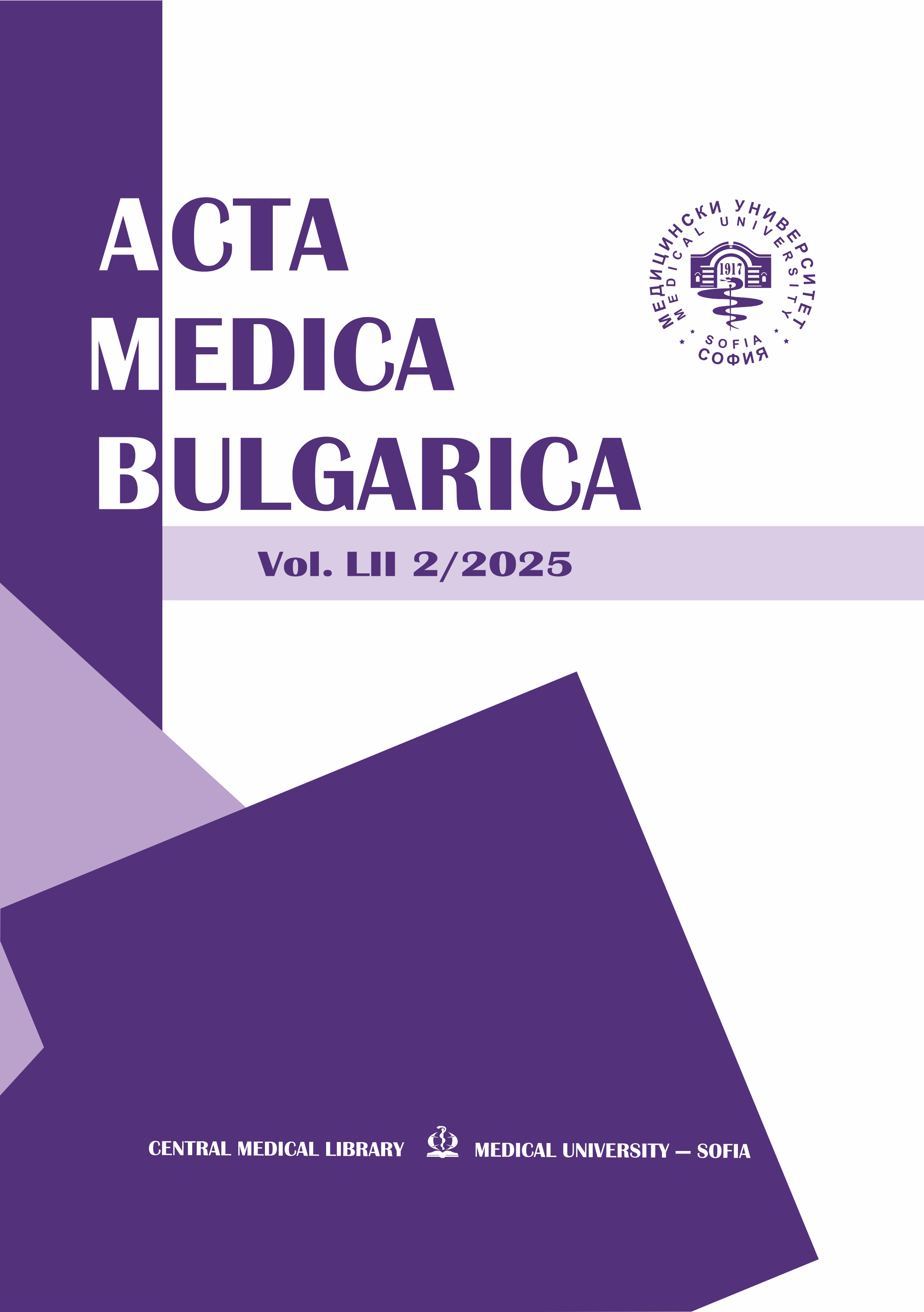Contrast sensitivity and asthenopia analysis for workers
DOI:
https://doi.org/10.2478/AMB-2025-0038Keywords:
contrast sensitivity, asthenopia, length of work, near vision activitiesAbstract
In the digital age, complaints of eyestrain, or asthenopia, have become increasingly common. This condition is often associated with prolonged near-work activities, such as extended use of computers or digital devices, with reported prevalence rates ranging from 40% to 90%. Eye fatigue is influenced by a decline in the eye’s accommodative capacity. Optimal visual function and acuity contribute to reducing visual discomfort by enhancing contrast sensitivity – the ability to clearly and precisely discern the boundaries of microscopic or fine detail objects. Materials and Methods: The study design was observational analytics and a cross-sectional approach. The number of patients was 94 people aged 18-60 years, without having anatomical abnormalities of the eye in the form of corneal opacities, cataracts, turbidity of refractive media, and retinal abnormalities. Research instruments in the form of asthenopia questionnaires and Pelli Robson charts were used to examine eye contrast sensitivity. Results: 84% of respondents in this study were aged > 25 years, 72.4% had worked for > 2 years, and 34% did close viewing activities for 2-5 hours/day. The incidence of asthenopia was 76.6%, and 96.8% had normal eye contrast sensitivity ability. Analysis using the chi-square test showed no significant relationship (p = 1,000) between contrast sensitivity and asthenopia. Conclusion: There was no significant relationship between contrast sensitivity and asthenopia.
References
Peraturan Menteri Kesehatan Republik Indonesia Nomor 25 Tahun 2016 Tentang Rencana Aksi Nasional Kesehatan Lanjut Usia Tahun 2016-2019 [Internet], Available from: http:// hukor.kemkes.go.id/uploads/produk_hukum/PMK_No._25_ ttg_Rencana_Aksi_Nasional_Kesehatan_Lanjut_Usia_Tahun_2016-2019_.pdf.
Firdani F, Sari PN, Alfian AR. Study Of Visual Fatigue Due To Extended Gadget Use During The Covid-19 Pandemic. ijph, 2023,18(2), 219-229. DOI:https://doi.org/10.20473/ijph. v18i2.2023.219-229.
Sawaya RIT, Meski NEI, Saba JB, et al. Asthenopia Among University Students: The Eye of the Digital Generation. J Family Med Prim Care, 2020, 9(8), 3921-3932. doi: 10.4103/ jfmpc.jfmpc_340_20.
Han CC, Liu R, Liu RR, et al. Prevalence of asthenopia and its risk factors in Chinese college students. Int J Ophthalmol, 2013, 6(5), 718-722.
Chandra J, Kartadinata E. Hubungan antara durasi aktivitas membaca dengan astenopia pada mahasiswa. J Biomedika dan Kesehat, 2018, 1(3), 185-190.
Gumunggilung D, Doda DVD, Mantjoro EM. Hubungan Jarak Dan Durasi Pemakaian Smartphone Dengan Keluhan Kelelahan Mata Pada Mahasiswa Fakultas Kesehatan Masyarakat Unsrat Di Era Pandemi Covid-19. J Kesmas, 2021, 10(2), 12.
Pane JP, Saragih IS, Laoli TL. Hubungan lama penggunaan gadget dengan kejadian astenopia pada mahasiswa program studi ners. J Penelit Perawat Prof, 2022,4(3), 947-954. Available from: http://jurnal.globalhealthsciencegroup.com/index.php/JPPP
Fernanda N, Amalia H. Hubungan akomodasi insufisiensi dan astenopia pada remaja di Jakarta Barat. J Biomedika dan Kesehat, 2018, 1(1),10-17.
Kaur K, Gurnani B. Contrast Sensitivity. 2023 Jun 11. In: StatPearls [Internet]. Treasure Island (FL): StatPearls Publishing, 2024 Jan–, Available from: https://pubmed.ncbi.nlm.nih.gov/35593849/
Ichhpujani P, Thakur S. An Overview of Spaeth/Richman Contrast Sensitivity (SPARCS): A Web-based, Contrast Sensitivity Testing Tool. TouchREVIEWS in Opthalmology, 2024, 18(1), 18-24.
Pratama PPAI, Setiawan KH, Purnomo KI. Asthenopia: Diagnosis, Tatalaksana, Terapi. Ganesha Med, 2021, 1(2), 97-102.
Killeen OJ, De Lott LB, Zhou Y, et al. Population Prevalence of Vision Impairment in US Adults 71 Years and Older: The National Health and Aging Trends Study. JAMA Ophthalmol, 2023,141(2), 197-204. doi:10.1001/jamaophthalmol.2022.5840
Pateras E, Karioti M. Contrast Sensitivity Studies and Test- Review. Biomed J Sci & Tech Res, 27(1)-2020. BJSTR. MS.ID.004439
Mc Kendrick AM, Sampson GP, Walland MJ, Badcock DR. Contrast sensitivity changes due to glaucoma and normal aging: low spatial frequency losses in both magnocellular and parvocellular pathways, Investigative Ophthalmology & Visual Science, 2007;48(5), 2115-2122.
Zheng F, Hou F, Chen Ret al. Investigation of the Relationship Between Subjective Symptoms of Visual Fatigue and Visual Functions. Front Neurosci, 2021,15,1-11.
Amalia H, Suardana GG, Artini W. Accommodative insufficiency as a cause of asthenopia in computer-using students. Universa Medicina, 2010, 29(2), 78-83. https://doi.org/10.18051/ UnivMed.2010.v29.78-83.
Singh H, Tigga MJ, Laad S, et al. Prevention Of Ocular Morbidity Among Medical Students By Prevalence Assessment Of Asthenopia And Its Risk Factors. J. Evid. Based Med. Health, 2016, 3(15), 532-536. doi: 10.18410/ jebmh/2016/122
Korpole NR, Kurada P, Korpole MR. Gender difference in ocular diseases, risk factors and management with specific reference to role of sex steroid hormones. J Mid-life Health, 2022,13, 20-25.
Zayed HAM, Saied SM, Younis EA, Atlam SA. Digital eye strain: prevalence and associated factors among information technology professionals, Egypt. Environmental Science and Pollution Research, 2021,20(2),25187-25195. doi: 10.1007/ s11356-021-12454-3
Gowrisankaran S, Nahar NK, Hayes JR, et al. Asthenopia and blink rate under visual and cognitive loads. Optom Vis Sci, 2012,89(1), 97-104.
Thorud HM, Helland M, Aarås A, et al. Eye-Related Pain Induced By Visually Demanding Computer Work. Optom Vis Sci, 2012,89(4), E452-E464.
Tawil LA, Aldokhayel S, Zeitouniwil L, et al. Prevalence Of Self-Reported Computer Vision Syndrome Symptoms And Its Associated Factors Among University Students. European Journal of Ophthalmology, 2020, 30(1), 189-195. https://doi.org/10.1177/1120672118815110
Szczotka-Flynn LB, Maguire MG, Ying GS, et al. Impact of Dry Eye on Visual Acuity and Contrast Sensitivity: Dry Eye Assessment and Management Study. Optom Vis Sci, 2019, 96(6),387-396.
Downloads
Published
Issue
Section
License
Copyright (c) 2025 H. Amalia, A. Adiwardhani, A. Devita, M. Pratiwi, R. Witjaksana, A. Dewi, E. Yousif (Author)

This work is licensed under a Creative Commons Attribution-NonCommercial-NoDerivatives 4.0 International License.
You are free to share, copy and redistribute the material in any medium or format under these terms.


 Journal Acta Medica Bulgarica
Journal Acta Medica Bulgarica 